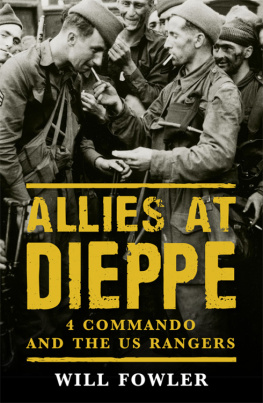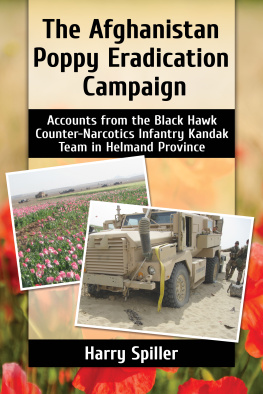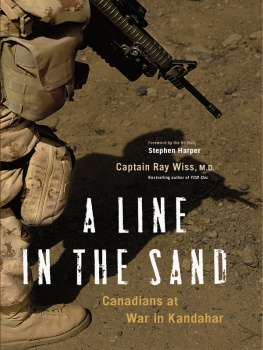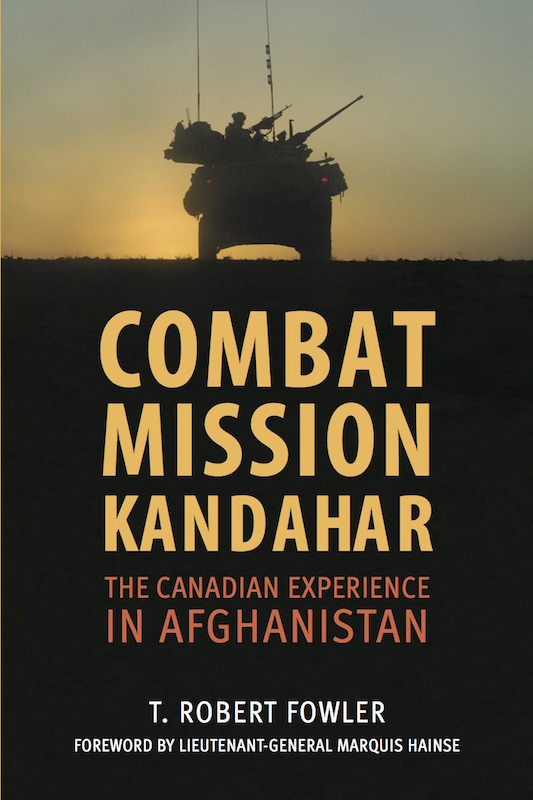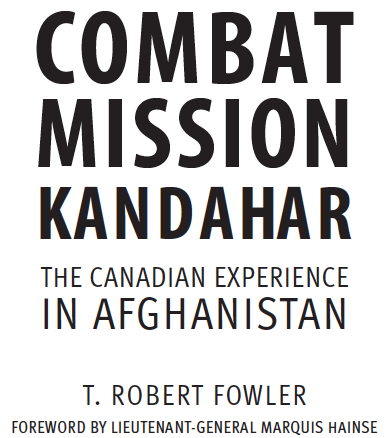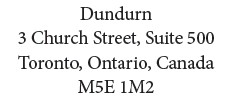Copyright
Copyright T. Robert Fowler, 2016
All rights reserved. No part of this publication may be reproduced, stored in a retrieval system, or transmitted in any form or by any means, electronic, mechanical, photocopying, recording, or otherwise (except for brief passages for purpose of review) without the prior permission of Dundurn Press. Permission to photocopy should be requested from Access Copyright.
Editor: Michael Carroll
Design: Jennifer Gallinger
Cover design: Sarah Beaudin
Cover image: David Strachan, George Metcalf Archival Collection, Canadian War Museum
Maps: Mike Bechthold
Epub Design: Carmen Giraudy
Library and Archives Canada Cataloguing in Publication
Fowler, T. Robert, author
Combat mission Kandahar : the Canadian experience in Afghanistan / T. Robert Fowler ; foreword by Lieutenant-General Marquis Hainse.
Includes bibliographical references and index.
Issued in print and electronic formats.
ISBN 978-1-4597-3516-3 (paperback).--ISBN 978-1-4597-3517-0 (pdf).--ISBN 978-1-4597-3518-7 (epub)
1. Afghan War, 2001- --Participation, Canadian. 2. Afghan War, 2001- --Campaigns--Afghanistan--Kandahr. 3. Afghan War , 2001- --Regimental histories--Canada. I. Title.
DS371.412.F69 2016 958.1047 C2016-902737-6
C2016-902738-4
We acknowledge the support of the Canada Council for the Arts and the Ontario Arts Council for our publishing program. We also acknowledge the financial support of the Government of Canada through the Canada Book Fund and Livres Canada Books, and the Government of Ontario through the Ontario Book Publishing Tax Credit and the Ontario Media Development Corporation.
Care has been taken to trace the ownership of copyright material used in this book. The author and the publisher welcome any information enabling them to rectify any references or credits in subsequent editions.
J. Kirk Howard, President
The publisher is not responsible for websites or their content unless they are owned by the publisher.
Visit us at: Dundurn.com | @dundurnpress | Facebook.com/dundurnpress | Pinterest.com/dundurnpress
Foreword
C anada s military involvement in Afghanistan was a significant period for the Canadian Armed Forces as a whole, but particularly for the Canadian Army. Our participation spanned a decade and involved thousands of officers, non-commissioned officers, and soldiers, many of whom deployed multiple times. It left a lasting mark on Canadians who were either directly involved in the conflict or supported those who were overseas. Consequently, in order to truly comprehend the impact of our operations in Afghanistan on those who were there, it is necessary to understand their stories.
Combat Mission Kandahar elaborates on a number of individual experiences across the duration of our armys participation in the combat mission in southern Afghanistan from 2006 to 2011. While it does not encapsulate the totality of our national contribution, the strength of this work is that it does provide one with an idea of the diversity of Canadian involvement in the conflicted area and the effect of the fighting on those who were deployed to that region.
While a comprehensive history of Canadas activities in Afghanistan remains to be published, the separate stories of those involved stand on their own merits. Each member of the Canadian Armed Forces who was part of our mission, myself included, has a tale to tell. This grouping represents a few of those from the Canadian Army. I commend one to read them and reflect on the individual experiences contained within the covers of this book. Also, while reading these stories, I ask that the reader remember all those who were part of Canadas involvement in Afghanistan, as well as their families and friends. It is by remembering and acknowledging their vast contributions that we continue to honour their sacrifices.
Vigilamus pro Te (We stand on guard for thee).
Lieutenant-General Marquis Hainse
Chief of the Army Staff and Commander of the Canadian Army
Preface
W hat is it like to go into combat? I have wondered about that question since growing up as a young boy in the 1940s. I was surrounded by radio broadcasts about the Second World War in Europe, films glorifying the deeds of soldiers, and articles on the front pages of newspapers that contained maps of faraway places like North Africa and Italy. It was all fascinating to the mind of a young, impressionable person. After the war was over, I could not wait to solve the mystery of what it was all about by getting the first popular histories that were published.
It could be said I was easily brainwashed at that early age by all I heard or saw. This led me to join the Air Cadets, Army Cadets, and along with my buddies, the local reserve army unit. It was only a long time later after reading more realistic histories and memoirs that I came to understand that war had few redeeming features, that it is brutal, ugly, and should be avoided at all costs. I might have been fortunate that I grew up between wars and therefore did not follow the lure of excitement that in every generation causes many to enlist when wars break out.
However, wars and conflicts continued to happen, and I believe that despite our best efforts to promote peace they will persist. I still find military history fascinating, since it tells an important part of human existence. And I am not the only one attracted to military history. I have been surprised at the number of people I have met at book signings, not only male but female, as well, who are similarly attracted to this genre. They are not warmongers but probably, just like me, they want to know what happened during these critical events in history. What lessons can be learned from these histories to make ourselves secure from aggressors who still exist in the world?
My interest in the combat mission in Afghanistan is no different than my desire to understand what happened at Hill 667 in 1951, on Juno Beach in 1944, or in front of Ypres in 1915. When the Canadian Army deployed troops to Kandahar in 2006, few of us realized that our military would become involved in the most extended period of conflict in the history of our country. Most people and politicians believed the mission would be a kind of brief peace-enforcement action that would allow the new Islamic government of Afghanistan to rebuild its war-torn country. Instead, Canadian soldiers became involved in a multi-year conflict in which all their combat skills were needed to fight a determined and deadly insurgency. Soldiers were killed and wounded, and for the first time decorations for military valour were awarded.
The combat mission was well covered by Canadian journalists. However, their short reports, published in newspapers and magazines or on television and radio, could only give brief glimpses of events. A number of books came out within a few years of the end of the mission, but these only recounted a small slice of the story, as well. Perhaps the most complete picture of the intensity of the mission was provided by the book Kandahar Tour , but it covered only one rotation. Several books focused on Operation Medusa, but what came afterward? Any interested reader had to struggle to put the pieces together from news articles and government media releases.



